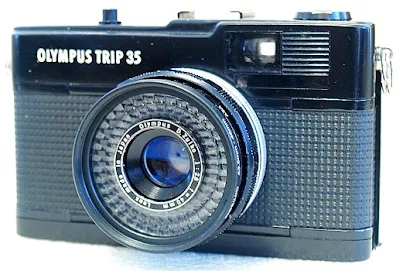The Olympus Trip 35, a 35mm compact camera manufactured by Olympus, was introduced in 1967 and stayed in production until 1984. Targeted at people who wanted a compact, functional camera for holidays or family snapshots, the camera was the subject of an advertising campaign featuring a popular British photographer David Bailey.
The Olympus Trip 35 is fitted with a D.Zuiko 40mm F2.8 lens and it does not need a battery to operate. The camera is powered by a selenium light meter, comes with two shutter speeds, 1/40 and 1/200 second, and two exposure settings, 'A' for Program automatic, and a manual aperture opening selection for shots at the lower 1/40 second, the setting for flash photography.
In Program automatic mode, the camera will choose either a shutter speed of 1/40 or 1/200 second, matched to an aperture range from F2.8 to F16. The film ISO setting is from 25 to 400 for later models which come with a black shutter release button, and 25 to 200 for earlier models that have a chrome silver shutter release button.
Focusing is by a zone system with four distance icons set for portrait, shoulder shot, group, and landscape. The distance icon is visible through the viewfinder via a small sub-window located just below the image frame. Flash is used in manual mode with a preset aperture opening.
The mainstay of the camera is undoubtedly its four-element three-group Tessar lens which is acknowledged as very impressive. The lens is capable of giving you sharp high-quality images with good mid-tone contrast and natural colors. Just as endearing is the use of the selenium photocell, which is even capable of getting a correct exposure under bright fluorescent light, without a flash.
Over its production run, more than 10 million units of the camera were produced and sold.








No comments:
Post a Comment